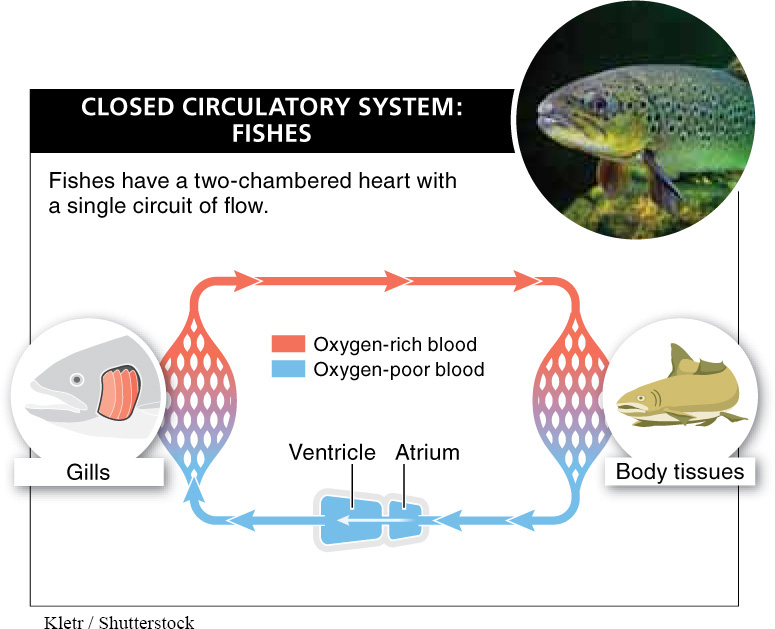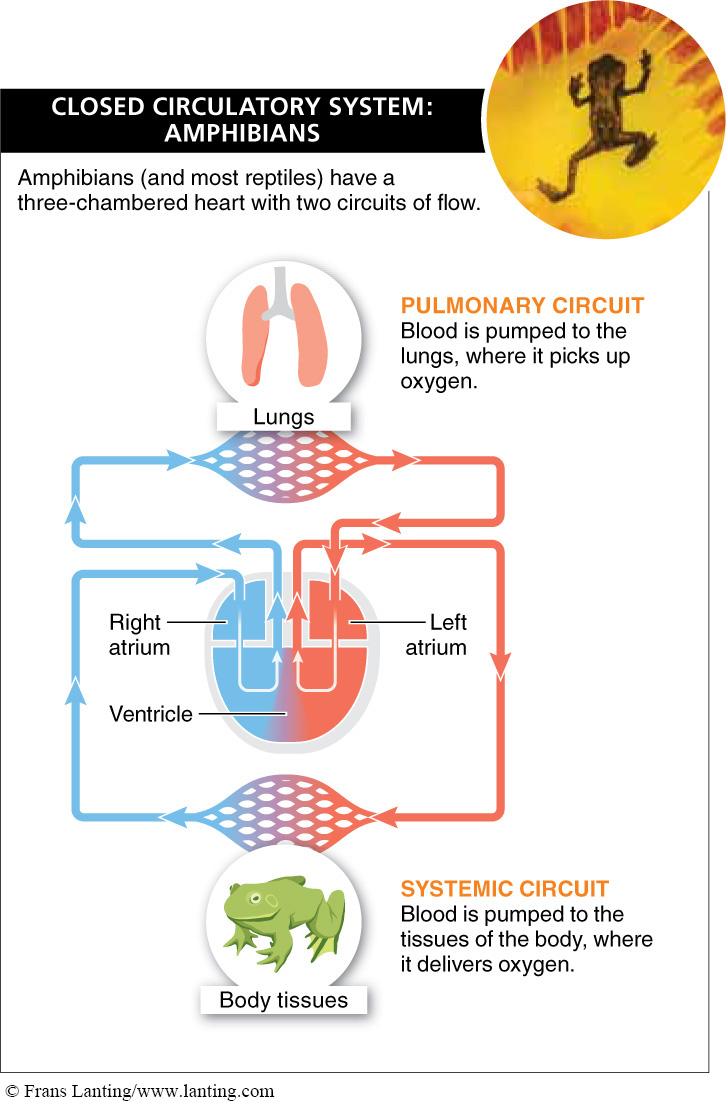21.3: Vertebrates have several different types of closed circulatory systems.

Figure 21.5: Blood flow in fishes.

Figure 21.6: Blood flow in mammals and birds. Note that the right side of the animal’s heart is on the left side in this diagram, and the left side is on the right. This is because the heart is drawn as if the animal were facing you.
Among the vertebrates, there are several variations of the closed circulatory system. These variations evolved in concert with numerous dramatic adaptations that accompanied and made possible the transition from life in the seas to life on land. As some vertebrates developed lungs and the ability to extract oxygen from the air rather than water, their circulatory systems increased in complexity. Here we give a broad overview of the structures and functions of the various types of closed circulatory systems. In the sections that follow, we discuss the components of these systems (heart, blood vessels, blood) in more detail.
In fishes, blood flow follows a circular path (FIGURE 21-5). In tracing the flow, we can begin with the two-chambered heart. Blood first passes into the atrium, the collecting chamber, and from there is pumped into the ventricle, the chamber from which it is pumped to the gills. Blood flows through the gills, where it picks up oxygen. The friction that the blood encounters as it flows through the millions of blood vessels in the gills causes the blood to lose most of the pressure it had as it was pumped from the heart. From the gills, the blood flows to the tissues of the body, delivering the oxygen. After passing through the body tissues, the oxygen-poor blood flows back to the heart, and the cycle begins again as that blood is pumped to the gills.
In contrast to the two-chambered heart of fishes, birds and mammals have a four-chambered heart with two atria and two ventricles (FIGURE 21-6). Twice as many chambers are required because, rather than having a single circuit of flow, birds and mammals have two circuits of flow. The two circuits can be visualized as a figure 8: oxygen-poor blood flows through the body into the right atrium and through to the right ventricle (see Figure 21-6). From there it is pumped out to the lungs, where it picks up oxygen, and then returns to the heart. This first circuit of blood flow, between the heart and the lungs, is called the pulmonary circuit.
The oxygen-rich blood that returns from the lungs to the heart collects in the left atrium. The blood immediately passes into the muscular left ventricle and from there is pumped at great pressure to the rest of the body. After passing through the body and delivering its nutrients and oxygen to body tissues, the now oxygen-poor blood travels back to the right atrium, and the cycle begins again. This second circuit of blood flow, between the heart and the rest of the body, is called the systemic circuit.
Mammalian and bird hearts vary widely in size—from hummingbird hearts no bigger than a pencil eraser to blue whale hearts, which are bigger than a small car and pump 25 gallons with every beat. Regardless of size, all of these hearts share the same basic layout. And almost always, because the left ventricle has to pump blood to the entire body rather than just to the lungs, the left ventricle becomes much larger and more muscular than the right ventricle.
Q
Question
21.1
Why is the left side of mammalian and bird hearts always bigger than the right?

Figure 21.7: Blood flow in amphibians.
With two circuits of flow, mammalian and bird hearts are better than fish hearts at delivering oxygen to body tissues. In fishes, as we learned earlier, all the oxygenated blood flowing to the body has low pressure and velocity, because it passes first through the blood vessels in the gills. With the two circuits of flow in birds and mammals, all the oxygenated blood flowing to body tissues is at higher pressure, because it is pumped directly from the left ventricle and does not first pass through the pressure-robbing blood vessels of the lungs. This makes it possible for bird and mammalian hearts to sustain greater levels of activity, with greater amounts of oxygen delivered to the muscles and organs. Nonetheless, the large number and diversity of fishes on earth suggests that they have been able to thrive with their single-circuit system.
Amphibians have circulatory systems that are similar to the mammalian and bird systems (FIGURE 21-7). They have two circuits of flow, but have a heart with only three chambers rather than four. Blood from the lungs and from the rest of the body collects in the left and right atria, respectively, but it then flows into a single ventricle. Surprisingly, though, little mixing of the oxygenated blood from the lungs and the deoxygenated blood from the rest of the body occurs in the ventricle. Rather, the two types of blood flow side by side and are pumped into arteries, which direct the oxygenated blood to the body and the deoxygenated blood to the lungs.
With the exception of birds, most reptiles also have three-chambered hearts, although the ventricle is partially divided into two. In one group of reptiles (the crocodilians), however, the division is complete; they also have an extra little artery through which blood can be pumped from the right ventricle to the rest of the body rather than to the lungs. This extra artery is an adaptation that allows the crocodile to bypass sending blood to the lungs when the animal is underwater. There is no sense in pumping blood to the lungs if there is no oxygen to be picked up there. Instead, the blood is sent back to the body, where the remaining oxygen in the blood can be utilized.
TAKE-HOME MESSAGE 21.3
Vertebrates’ circulatory systems vary in structure. Fishes have two-chambered hearts, with one circuit of flow: from the heart through the gills, then through the body and back to the heart. Birds and mammals have four-chambered hearts and two circuits of flow: from the heart to the lungs and back to the heart, then from the heart to the body and back to the heart. This enables blood to be pumped to the body at higher pressure. Amphibians and most reptiles have a three-chambered heart and two circuits of blood flow.
Why do birds and mammals have a four-chambered heart whereas fish only have a two-chambered heart?


